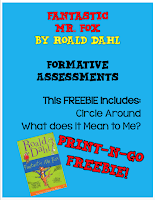Formative Assessment is Not for Grading
I will say it again, formative assessment is not used for grading,
but rather is an opportunity for students to learn and for teachers to fill in
any gaps –before they are graded. Formative assessment is used before
instruction to discover what students know and during instruction to find out students’
level of understanding and just how they are progressing towards a particular learning
goal.
Because formative assessment isn’t used for grading,
students are comfortable making mistakes and asking for help. They are free to
do their work, without the cloud of a grade hanging over them. Evidence
suggests that the best students use all information formatively. Struggling
students, however, are more apt to have negative feelings after failure. These feelings
often get in the way of student learning. For struggling students, the value of
any feedback is lost – overshadowed by low grades. Formative assessment offers
the opportunity for every student to learn to use and value feedback.
What Formative Assessment Looks Like in a Fifth Grade Classroom
 Close your eyes and imagine you are a fifth-grade teacher
and today’s learning goals include applying reading standards for literature,
specifically: RL 5.1.1 and 5.1.2: Quote accurately from a text when
explaining what the text says explicitly and when drawing inferences from the
text.
Close your eyes and imagine you are a fifth-grade teacher
and today’s learning goals include applying reading standards for literature,
specifically: RL 5.1.1 and 5.1.2: Quote accurately from a text when
explaining what the text says explicitly and when drawing inferences from the
text.
This is a new skill for fifth grade and students are working
on interactive notebook pages for the
novel the class is reading. In their
reading, they have analyzed the text and participated in a “Prediction”
Think-Pair-Share – to call upon skills they learned the previous year. You are
scaffolding on this information to help your students understand “inference.”
As students work, you sit with Billy to discuss his
notebook. You have a three-ring binder open to a page with the headings: Child’s
Name/Date, RL 5.1 Making Inferences, Teaching Point and What’s Next for this
Child? Farther down the page is a sticky note listing five students’ names. These
are the five children you will assess today.
Your initial purpose is to follow-up on feedback you
provided two days ago based on evidence elicited from an interaction with Billy;
in that previous interaction, you determined he struggled with predicting –
thus making inference difficult.
You: You are working on inference – you know – coming
to a conclusion made by connecting what
you already know with the new information
we’re reading in x novel.
Billy: Well, in the
first chapter of the Fantastic Mr. Fox, the mean and nasty farmers eat things
they raise: chickens, geese, ducks and turkeys. I know that foxes like to eat
these things.
You: Good, so what can you infer from that?
Billy: I can infer that there will be some problem with the fox
and the farmers chickens, geese, ducks and turkeys.
You help Billy recognize what an inference is and review his
work. As you are working with Billy you are filling out your formative
assessment binder.
After you circulate the room, you realize that many of your
students just aren’t grasping the connection between prediction and inference,
so you pull together a mini-lesson.
You’ve quickly and simply learned what students know and do
not know, you have the information tucked away in your binder and should
continue to refer to the information in your binder to drive instruction.
Formative Assessment Freebie: The Fantastic Mr. Fox
43- Formative Assessments for Classroom Use
FREE! 2nd grade NBT.1 Formative Assessment!
Book Two: 60 Formative Assessment Strategies
Formative Assessment Freebie: The Fantastic Mr. Fox
43- Formative Assessments for Classroom Use
FREE! 2nd grade NBT.1 Formative Assessment!
Book Two: 60 Formative Assessment Strategies
Please follow me:
Pinterest: https://www.pinterest.com/epinotti/boards/
Twitter: https://twitter.com/chapinpinotti
Google +: https://plus.google.com/u/0/
Tumblr: https://www.tumblr.com/dashboard
Facebook: https://www.facebook.com/ReadingAllAround/
Thanks,
Elizabeth Chapin-Pinotti
#Chapin-Pinotti
Thanks,
Elizabeth Chapin-Pinotti
#Chapin-Pinotti





